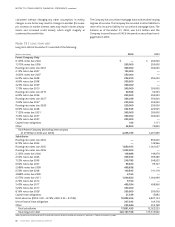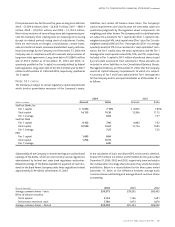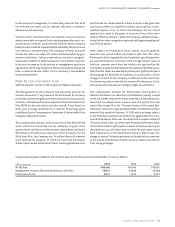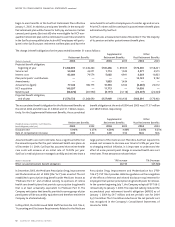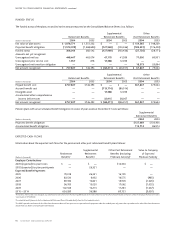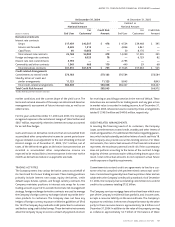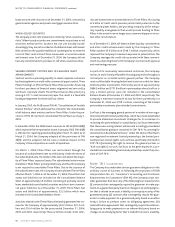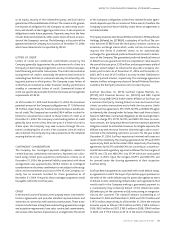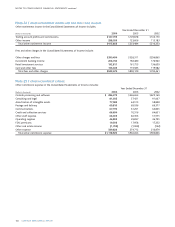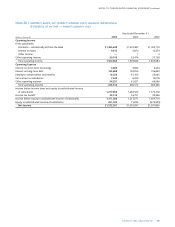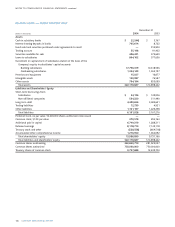SunTrust 2004 Annual Report Download - page 98
Download and view the complete annual report
Please find page 98 of the 2004 SunTrust annual report below. You can navigate through the pages in the report by either clicking on the pages listed below, or by using the keyword search tool below to find specific information within the annual report.
96 SUNTRUST 2004 ANNUAL REPORT
NOTES TO CONSOLIDATED FINANCIAL STATEMENTS continued
The Company manages the credit risk of its derivatives and
unfunded commitments by limiting the total amount of arrange-
ments outstanding by individual counterparty; by monitoring the
size and maturity structure of the portfolio; by obtaining collateral
based on management’s credit assessment of the counterparty; and
by applying uniform credit standards maintained for all activities
with credit risk. Collateral held varies but may include marketable
securities, accounts receivable, inventory, property, plant and equip-
ment, and income-producing commercial properties.Collateral may
cover the entire expected exposure for transactions or may be
called for when credit exposure exceeds defined thresholds of credit
risk. In addition, the Company enters into master netting agree-
ments which incorporate the right of setoff to provide for the net
settlement of covered contracts with the same counterparty in the
event of default or other termination of the agreement.
DERIVATIVES
The Company enters into various derivative contracts both in a
dealer capacity, to facilitate customer transactions, and also as a
risk management tool.Where contracts have been created for cus-
tomers, the Company enters into transactions with dealers to offset
its risk exposure. Derivatives are also used as a risk management
tool to hedge the Company’s exposure to changes in interest rates
or other defined market risks.
Interest rate swaps are contracts in which a series of interest rate
cash flows, based on a specific notional amount and a fixed and
floating interest rate, are exchanged over a prescribed period. Caps
and floors are contracts that transfer, modify,or reduce interest rate
risk in exchange for the payment of a premium when the contract is
issued.The true measure of credit exposure is the replacement cost
of contracts that have become favorable to the Company.
Futures and forwards are contracts for the delayed delivery of secu-
rities or money market instruments in which the seller agrees to
deliver on a specified future date, a specified instrument, at a speci-
fied price or yield.The credit risk inherent in futures is the risk that
the exchange party may default. Futures contracts settle in cash
daily; therefore, there is minimal credit risk to the Company. The
credit risk inherent in forwards arises from the potential inability of
counterparties to meet the terms of their contracts. Both futures
and forwards are also subject to the risk of movements in interest
rates or the value of the underlying securities or instruments.
Derivative instruments expose the Company to credit and market
risk. If the counterparty fails to perform, the credit risk is equal to
the fair value gain of the derivative.When the fair value of a deriva-
tive contract is positive, this indicates the counterparty owes the
Company, and therefore, creates a repayment risk for the Company.
When the fair value of a derivative contract is negative, the
Company owes the counterparty and has no repayment risk. The
Company minimizes the credit or repayment risk in derivative
instruments by entering into transactions with high quality coun-
terparties that are reviewed periodically by the Company’s credit
committee.The Company also maintains a policy of requiring that
all derivative contracts be governed by an International Swaps and
Derivatives Associations Master Agreement; depending on the
nature of the derivative transactions, bilateral collateral agree-
ments may be required as well.When the Company has more than
one outstanding derivative transaction with a single counterparty,
and there exists a legally enforceable master netting agreement
with the counterparty, the mark to market exposure is the net of the
positive and negative exposures with the same counterparty. When
there is a net negative exposure, the Company considers its expo-
sure to the counterparty to be zero.The net mark to market position
with a particular counterparty represents a reasonable measure of
credit risk when there is a legally enforceable master netting agree-
ment, including a legal right of setoff of receivable and payable
derivative contracts between the Company and a counterparty.
Market risk is the adverse effect that a change in interest rates, cur-
rency or implied volatility rates has on the value of a financial
instrument.The Company manages the market risk associated with
interest rate, credit, and equity derivatives and foreign exchange
contracts by establishing and monitoring limits on the types and
degree of risk that may be undertaken.The Company continually
measures this risk by using a value-at-risk methodology.
FAIR VALUE HEDGES
The Company enters into interest rate swaps to convert its fixed
rate funding to floating rates. For the years ended December 31,
2004 and 2003, the Company recognized additional income in the
net interest margin of $197.7 and $130.7 million, respectively,
related to cash payments from net settlements and income accrued
for interest rate swaps accounted for as fair value hedges.This hedg-
ing strategy resulted in zero ineffectiveness as of December 31,
2004 and ineffectiveness that reduced earnings by $0.3 million for
the year ended December 31, 2003.
The Company maintains a risk management program to protect and
manage interest rate risk and pricing risk associated with its mort-
gage lending activities. The following derivative instruments are
recorded in the financial statements at fair value and are used to
offset changes in value of the mortgage inventory due to changes in
market interest rates: forward contracts, interest rate lock commit-
ments and option contracts.A portion of the forward contracts have
been documented as fair value hedges of specific pools of loans that
meet the similar assets test as described in SFAS No. 133.The pools
of hedged loans are recorded in the financial statements at their fair
value, resulting in a partial offset of the market value adjustments
on the forward contracts.The pools of loans are matched with a cer-
tain portion of a forward contract so that the expected changes in
market value will inversely offset within a range of 80% to 125%.
This hedging strategy resulted in ineffectiveness that reduced earn-
ings by $50.0 million and $149.7 million for the years ended
December 31, 2004 and 2003, respectively.
CASH FLOW HEDGES
The Company uses various interest rate swaps to convert floating
rate assets and liabilities to fixed rates. Specific types of funding and
principal amounts hedged were determined based on prevailing


